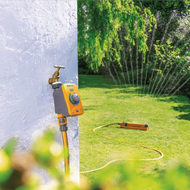Golden Rules for Smart Garden Watering
Posted by Original on 19th Jul 2022
We all want to keep our garden healthy and thriving, especially through those lush, warmer summer months. But finding the perfect way to water your garden is not always as simple as it sounds. So to help you have the greenest thumb on your street, and a wonderful place to relax, we've put together the golden rules of watering to help you get it right.
And if you're looking for more ways to save on water whilst keeping your garden healthy, here's everything you need:
- Looking to harvest rainwater? Check out our range of water butts
- Want to set up a system that will work even when you're away? Check out our range of automatic watering systems
Here are our top tips, follow them for a garden full of thriving plants!
1. Only water plants that are dry, and water thoroughly to soak the roots
Over-watering plants and leaving them water-logged will reduce the amount of air that can reach the roots, which is really important for plant growth. Watering little and often will also mean that the water doesn't reach the rootball, leaving your plants parched. It's best to wait until they are fully dry (you can test this by putting your finger into the soil up to your knuckle) and then give them a good soaking, a great way to encourage strong roots.
2. Keep crops evenly moist through key growing seasons
Whilst leaving many plants to dry out and then soaking may be beneficial to growth, it can affect the crops on many plants, especially plants like tomatoes which must be kept evenly moist during the fruiting season, or they can succumb to blossom-end rot or fruit drop.
3. Water early in the morning or later in the evening (avoiding midday)
Watering early in the morning or later in the evening ensures that plants can be thoroughly hydrated before the water starts to evaporate in the heat of the midday sun. It also means that leaves won't be burnt by the heat of the sun, which causes a greenhouse effect on the water droplets sitting on leaves. If you do water later in the day, make sure you don't wet the leaves as this can lead to leaf mould and other diseases if plants sit damp through the cooler nights.
4. When watering, ensure you soak the soil on all sides of the plant
It's always best to make sure you soak all areas of a plant, rather than just on one side as this will lead to uneven root growth. It's also always a good idea to water in parts, allowing the water to seep into the soil before applying more.
5. Use good quality compost, suited to your plants
How well your plants stay hydrated will depend greatly on the quality and suitability of your soil. Clay-rich soils hold a lot more moisture and minerals in them, but may need aeration and drainage adding by the addition of organic compost. Sandy soils can also be enriched by the addition of organic compost, which will also add much-needed nutrients. Find our range of compost bins.






